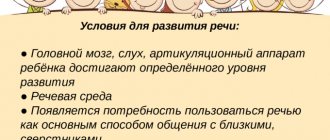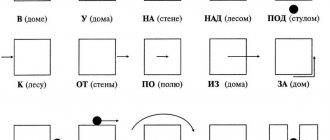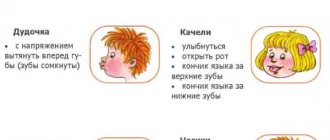Automation of the R sound in phrases (with two R sounds in words):
| Smooth bars. Roma has bronchitis. Brave officer. Bronze award. See your brother off. Splash in the pond. | Throwing a cork. Jump from the mountain. Elastic spring. A simple pencil. We saw a zebra and a cobra. Walk down the aisle. |
Reasons for violation
Speech problems arise in a child for various reasons. If only the pronunciation aspect of speech is impaired, that is, the preschooler does not pronounce one or more sounds, then this is dyslalia.
Such a conclusion is made only after a detailed examination. The child's hearing acuity and muscle mobility of the speech apparatus are checked. If both components are normal, dyslalia is diagnosed.
It appears due to two main groups of factors. With the first, there are no deviations in the structure of the peripheral speech apparatus. The disorder is called functional dyslalia. It appears due to biological problems:
- frequent illnesses;
- problems during pregnancy and childbirth;
- minimal brain dysfunction.
It is impossible to establish exactly what became the catalyst for the violation. The social environment influences the formation of speech. Parents can deliberately distort speech, use primitive babbling words and lisp. All this does not contribute to correct sound pronunciation.
In dysfunctional families, there is limited contact. The child does not communicate with peers or adults. The formation of speech occurs not only during the perception of spoken words, but also the ability to use them. Without practice, there will never be pronunciation skills.
Mechanical dyslalia occurs due to disturbances in the structure of the articulatory apparatus. Sonoras (sounds “R”, “L” and soft pairs) require raising the tip of the tongue. A short hyoid frenulum limits the mobility of the organ.
It is easy to check the length of the ligament at home: the child is asked to open his mouth and lift his tongue. A small thin strip is visible from the bottom of the oral cavity to the organ - this is the frenulum. If it is short, then the tongue will not rise or will come off slightly from the lower jaw.
In rare cases, problems arise due to a high palate. This is a congenital anomaly. Bite problems do not affect the pronunciation of sonorous sounds.
There is a concept of age-related dyslalia. Groups of sounds appear at different periods - this is normal development. Sonoras are formed at five years of age. Until this moment, you don't have to worry.
Forms of rhotacism
Parents rarely hear defective sound. An experienced speech therapist will immediately identify it. It is rare to encounter a complete absence of the soft sound “R”. In this case, the child will say “tsa” instead of “king.”
Burr is called velar pronunciation. Due to the vibration of the soft palate, excess noise appears and the sound is distorted. With the uvular form, a small tongue works.
With lateral pronunciation, the vibration does not go to the tip of the tongue, but to its lateral edges. The form is characteristic of dysarthria, structural defects of the speech apparatus (short hyoid ligament).
In the bilabial form, the sound is created by trembling the lips, resulting in the combination “prrrrr”. It is sometimes called "coachman's".
Sometimes a child is able to say a single-beat “R”, in which case there is no tongue fluctuation. The output sounds distorted "D".
“Рь” can be replaced by different sounds: hard “R”, “L”, “Y”, “D” and others.
Diagnosis delimitation
Rotacism appears not only with dyslalia. With dysarthria, problems arise with the mobility of the muscles of the speech apparatus. In children, hypotonicity or hypertonicity is observed - weakness or tension of the articulation organs.
Preschoolers with dysarthria have:
- breathing problems – weak, superficial;
- increased salivation;
- coordination problems.
To make a diagnosis, special tests proposed by Arkhipova are used. The child is asked to open his mouth, stick out his tongue and follow the bright toy with his eyes. During testing, involuntary movements of the tongue are noticeable.
Sometimes a visual inspection is sufficient. The preschooler is asked to open his mouth, the tongue does not lie quietly in the cavity, but is gathered into a ball - this indicates hypertonicity. If he is lethargic and motionless, then this is hypotonicity.
With rhinolalia, defects in the structure of the articulatory apparatus are observed - these are clefts of the gums, lips, and palate. Corrective work begins after plastic surgery; it is structured differently than with dyslalia and dysarthria.
Disturbances in soft and hard sounds occur with general speech underdevelopment (GSD). With this conclusion, problems are observed in vocabulary, grammar, and coherent speech.
The sound R in phrases (in reverse syllables in the middle of words):
| Old hill. Northern city. Mischievous sparrow. Short pile. A bright picture. Black cardboard. | Sea wind. Beautiful stamps. Royal coat of arms. Stainless jacket. Collect potatoes. Carrot juice. |
Staging methods
A soft sound is placed after the introduction of a hard sound into speech - this is the traditional view of speech therapists. In some cases this cannot be done. Therefore, you can start delivery with “Ry”.
The techniques are standard: from other sounds or mechanically. For the latter, a probe or probe substitute is needed. The tool looks like a stick with a ball at the end. As a replacement, use skewers for canapés with a ball at the end, or a spatula with a silicone nipple.
Sound production is carried out in a lying position. The child opens his mouth, raises the tip of his tongue, quickly pronounces “D”, the speech therapist shakes the tongue with a probe, resulting in trembling.
When setting up sonors, it is allowed to start automation with syllables immediately.
The production of the sound “Th” has its own peculiarities: the sound is pronounced in an exaggerated, drawn-out manner, the lips are elongated in a smile. The child is asked to say “t-r-i.” A new sound will be heard, which is indicated by a symbol.
It is effective to set the sound from “Зь”. To do this, the preschooler is asked to sing a mosquito song, but with the tip of the tongue raised up to the alveoli. The distorted sound is corrected by the movements of the probe and a drawn-out “zi” is pronounced, which turns into “ri”.
Automation of the sound P in phrases (in reverse syllables):
| New fence. The choir sings. Raya has a tan. Home yard. Strong boxer. Poisonous fly agaric. To push back. I'll go to the market. | Delicious marshmallow. Russian cheese. Drink kefir. Buy a samovar. Fairy tale "Moidodyr". Number five. Embroider a pattern. I'll sweep the yard. |







